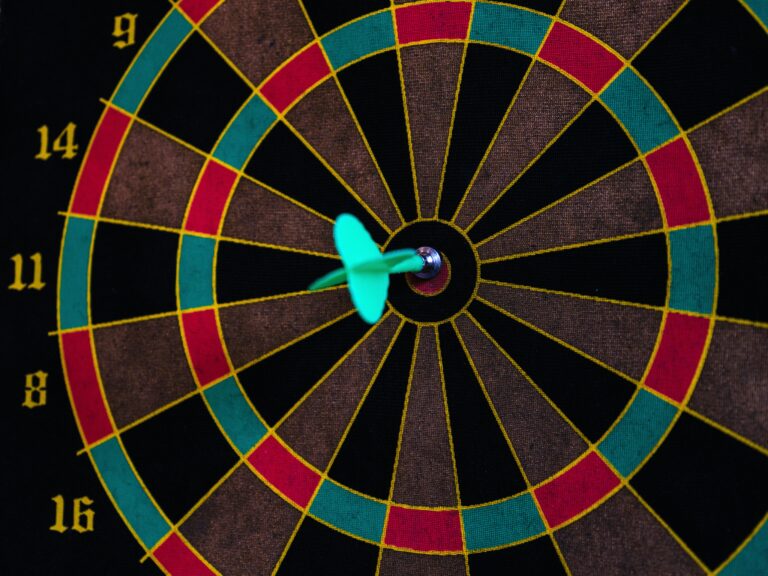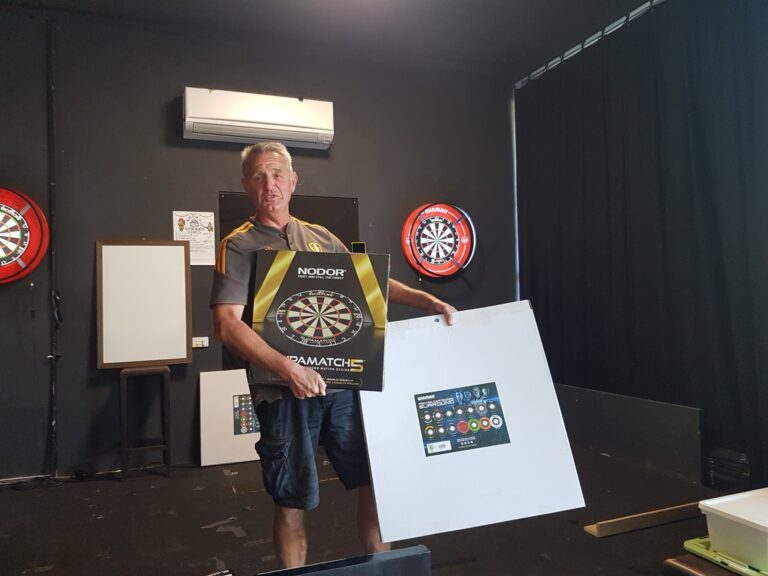Uncovering Darts’ Historical Roots: 10 Key Moments
You probably don’t know that darts originated in mediaeval England, evolving from soldiers and archers throwing short arrows to hone their skills. This practice laid the groundwork for what would become a beloved sport. The dartboard’s design, resembling a clock face, holds fascinating historical significance. Fast forward to 1908; the first recorded indoor darts match marked a pivotal moment, forever changing its trajectory. By understanding these key moments, you’ll gain a deeper appreciation for the sport’s rich heritage and how it reached global popularity. Let’s explore these ten milestones that shaped darts into what they are today.
Key Takeaways
- Darts originated in mediaeval England, evolving from soldiers and archers throwing short arrows for practice.
- The first recorded indoor darts match took place in the early 20th century, marking a significant milestone.
- The British Dart Organisation (BDO) was founded in 1973, standardising rules and elevating darts to a competitive sport.
- Phil Taylor’s dominance in modern darts significantly influenced the sport’s popularity and professionalism.
- The World Darts Championship’s growth and iconic matches have contributed to the sport’s global reach and prestige.
Origin in Medieval England
Darts began in medieval England, likely evolving from archery practices. Picture medieval soldiers and archers honing their skills during downtime by throwing short arrows at barrels or tree trunks. This pastime gradually transformed into a more organized activity.
The dartboard design we recognize today, resembling a clock face, has deep historical roots in England. The segmented pattern you see on modern boards was devised to challenge players by mixing high and low scoring areas. Over time, this design became standardized and remains a core part of the game.
The highest achievable score in darts, known as a perfect game, is 180 points. To hit this, you must throw three darts into the triple 20 segment. Achieving this feat requires incredible precision and skill, and it’s a highlight in any match.
The first recorded indoor darts match occurred in the early 20th century. This marked a significant milestone in the sport’s development, moving it from informal gatherings to more structured competitions. Since then, darts has continued to grow in popularity, evolving from its medieval roots to modern-day championships. This transformation showcases the game’s enduring appeal and rich history.
Evolution From Archery
The shift from archery to the modern game of darts showcases a fascinating journey of skill refinement and competitive spirit. Darts may have its origins in medieval England, where archers honed their skills by throwing shortened arrows at targets. This practice laid the foundation for the game we understand today.
Key moments in the evolution from archery to darts include:
- Mediaeval Practice: Archers used dart-like projectiles to practice indoors during bad weather, gradually turning it into a game.
- Military Influence: Soldiers carried the game across regions, spreading its popularity and evolving the rules.
- Indoor Matches: The first recorded indoor darts match in 1908 marked a significant milestone, evolving it from a pastime to a competitive sport.
- Standardisation: Establishing rules and the familiar dartboard design helped formalise the game, making it accessible to a broader audience.
The highest achievable score in darts, 180, adds a layer of challenge and excitement. This transformation reflects the enduring popularity and growth of darts, from its mediaeval roots to modern-day championships. Through these changes, darts have maintained their competitive edge and appeal, captivating enthusiasts worldwide.
The Clock Face Dartboard
You’ll find that the clock face dartboard has an intriguing history, marked by the evolution of its design and the standardization of rules.
Initially, the layout was meant to facilitate easy scoring and precise targeting.
Over time, these designs became more refined, setting the stage for the competitive dart games as they’re recognised today.
Evolution of Dartboard Design
Imagine standing before a dartboard, its iconic clock face design inviting you to aim and score. This design, with its numbered sections radiating outward from the centre, hasn’t just been about aesthetics; it plays an essential role in the game’s evolution and competitive nature.
Over time, the clock face dartboard has undergone several refinements to enhance gameplay and scoring accuracy. Here’s a quick look at how these changes have shaped the modern dartboard:
- Number Arrangement: The numbers are strategically placed to balance high and low scoring areas, challenging players to improve their precision.
- Bullseye Placement: Located at the centre, the bullseye offers a high point value, making it a key target that demands significant skill.
- Material Improvements: Early dartboards were often made from wood, but modern boards use sisal fibre, which heals itself after each hit.
- Wire Technology: Advancements in wire technology have minimised bounce-outs by making the wires thinner and more embedded into the board.
These enhancements haven’t only maintained the traditional look of the dartboard but also optimised its functionality for players. So, when you next throw a dart, remember—each aspect of that board has been fine-tuned to offer the best playing experience.
Standardisation of Rules
As design improvements refined the dartboard’s functionality, the standardisation of rules with the clock face dartboard fundamentally transformed how the game is played and scored. The clock face dartboard, resembling a clock with 20 numbered sections, introduced a consistent and universally accepted scoring system. Each section corresponds to a specific number, allowing players to aim for precise scoring areas.
This innovation revolutionised the game by providing a clear framework for scoring. No longer was there ambiguity in points; every dart thrown had a definitive value. Players could now strategically target different sections based on the point values assigned to each number, making the game more competitive and skill-based.
The standards set by the clock face design have endured. It remains a fundamental component of modern darts, shaping how players approach and score in the game. The consistent rules have also facilitated organised competitions and tournaments worldwide.
In essence, the clock face dartboard didn’t just standardise the game; it elevated it, bringing clarity and uniformity that continue to define darts today. This standardisation has been pivotal in transforming darts from a casual pastime into a recognised sport.
First Indoor Match, 1908
How did the first indoor darts match in 1908 transform the sport into an organised competitive game? This landmark event wasn’t just about moving the game indoors; it marked the beginning of a new era for darts.
By bringing the sport into a controlled environment, the 1908 indoor match allowed for the development of standardised rules and formalised competitions. It turned a casual pastime into a serious, competitive sport.
Here’s why this moment was so pivotal:
- Establishment of Formal Leagues: The indoor setting enabled the creation of structured leagues, promoting regular competition.
- Standardisation of Equipment: Standard dartboards and darts became a necessity, ensuring fair play and consistency.
- Increased Popularity: Indoor matches attracted more spectators, boosting the sport’s popularity and recognition.
- Foundation for Future Competitions: This event set the stage for future organised events, paving the way for national and international tournaments.
The significance of the 1908 match can’t be overstated. It transformed darts from a casual game played in pubs to a recognised competitive sport. This pivotal moment laid the groundwork for everything that followed, shaping the future landscape of darts.
Establishment of BDO, 1973
In 1973, the British Dart Organisation (BDO) was founded to govern and promote darts on a larger scale. Its formation brought structure and standardisation to the sport, allowing for organised national and international competitions.
This milestone helped elevate darts from a pub game to a recognised professional sport, giving players a platform to compete and showcase their skills.
Formation of BDO
The British Dart Organisation’s establishment in 1973 revolutionised the structure and support for professional darts in the UK. Before the BDO, there was no unified body to organise and regulate competitive darts events. This left many players without the necessary structure to advance their careers. The BDO changed all that.
By forming the BDO, the founders aimed to create a central governing body to oversee the sport. This move provided a much-needed framework, ensuring that competitive darts could grow and thrive at a national level.
Here’s what the BDO’s formation accomplished:
- Standardisation: The BDO set standardised rules and regulations for competitions, bringing consistency to the sport.
- Recognition: It elevated the status of darts, helping it gain recognition as a legitimate competitive sport.
- Support for Players: The organisation offered support to professional dart players, giving them the resources they needed to succeed.
- Event Organisation: The BDO took on the role of organising and promoting major darts tournaments across the UK.
Since 1973, the BDO has been instrumental in promoting and growing the sport, making it a pivotal moment in darts’ history.
Impact on Darts
By establishing the British Dart Organisation in 1973, the sport of darts saw an immediate transformation that significantly bolstered its professional and competitive landscape. The BDO played an essential role in organising and promoting darts competitions. This helped elevate the sport’s status in England and beyond, paving the way for a more structured and professional environment.
The creation of the BDO provided a platform for darts players to compete on a national level. This allowed them to showcase their skills and gain recognition. It also contributed to the sport’s growth, attracting a dedicated following of both players and fans. With the BDO’s support, darts competitions became more frequent and better organised, leading to an increase in the sport’s popularity.
The BDO’s foundation laid the groundwork for the professional darts scene. This led to the emergence of legendary players and iconic tournaments that would shape the sport for decades. The following table highlights the key impacts of the BDO’s establishment:
| Impact Area | Description | Result |
|---|---|---|
| Competition | Organised national-level tournaments | Increased professionalism |
| Popularity | Attracted more players and fans | Growth in sport’s fan base |
| Professional Scene | Laid foundation for legendary players | Emergence of iconic tournaments |
The BDO’s influence on darts cannot be overstated, as it transformed the game into a recognised and respected competitive sport.
Formation of PDC, 1992
Discontent over commercial opportunities and prise money distribution led to the formation of the Professional Darts Corporation (PDC) in 1992. This significant split from the British Darts Organisation (BDO) created a seismic shift in the world of professional darts. Players were frustrated with the limited financial rewards and saw an opportunity to enhance their careers and the sport’s visibility.
The PDC introduced a more lucrative and competitive circuit, attracting top players and revolutionising professional darts. Here are four key aspects:
- Improved Prise Money: The PDC offered substantially higher prise money, enticing many top players to join.
- Global Reach: The PDC expanded the sport’s global presence through international tournaments and broadcasts.
- Premier Events: The PDC World Darts Championship became a marquee event, showcasing the highest level of competition.
- Player Success: Notable players like Phil Taylor and Michael van Gerwen achieved immense success, raising the sport’s profile.
The establishment of the PDC marked a new era in darts, transforming it into a globally recognised and commercially viable sport. The changes they implemented have left an enduring impact, making darts more popular and profitable than ever before.
Phil Taylor’s Dominance
Phil Taylor’s unparalleled dominance in professional darts redefined the sport throughout the 1990s and early 2000s. Known as ‘The Power,’ Taylor’s precision and consistency set him apart from his competitors. He won a record 16 World Darts Championship titles during his career, a proof of his skill and tenacity. His incredible run of victories established him as one of the greatest darts players in history.
Taylor’s impact wasn’t just about the titles he won; it was about how he played. His accuracy on the dartboard was unmatched, and his ability to perform under pressure was legendary. Fans and aspiring players alike were in awe of his talent.
His rivalry with Raymond van Barneveld was particularly significant, enthralling audiences and raising the sport’s profile. These epic showdowns didn’t only entertain but also pushed the boundaries of what was possible in professional darts.
Even after his retirement, Taylor’s influence continues to shape the modern landscape of competitive darts. Aspiring players look up to him, aiming to emulate his dedication and skill. His legacy remains a cornerstone of the sport, reminding everyone what true excellence looks like.
The World Darts Championship
When you explore the origins and growth of the World Darts Championship, you’ll find it began in 1978 and has grown into one of the most prestigious events in the sport.
Iconic matches and players have graced the tournament, making it a highlight in the darts calendar.
With prise money now exceeding £2.5 million, the championship not only attracts top talent but also showcases the sport’s evolution.
Championship Origins and Growth
In 1978, the World Darts Championship made its debut, quickly establishing itself as a cornerstone of the sport. Organised by the Professional Darts Corporation (PDC), this tournament has become synonymous with top-tier competition and has drawn in dart enthusiasts worldwide.
Over the years, the championship has seen tremendous growth in popularity and viewership, making it one of the most watched events in the sport.
Here’s why the World Darts Championship has become such a pivotal event:
- Historic Significance: As one of the oldest darts tournaments, it holds a special place in the sport’s history.
- Prestige and Recognition: Winning this championship elevates players to legendary status.
- Electric Atmosphere: Held at the Alexandra Palace in London, the venue is known for its vibrant and intense environment.
- Global Audience: The tournament attracts viewers from around the globe, uniting fans in their love for the sport.
The championship’s setting at Alexandra Palace adds to its allure, with fans eagerly anticipating the high-stakes matches each year.
Winners are celebrated, their names etched into the annals of darts history, further cementing the tournament’s iconic status.
Iconic Matches and Players
Throughout its history, the World Darts Championship has showcased some of the most iconic matches and legendary players in the sport. Since 1978, this prestigious tournament has been the stage for unforgettable moments and intense rivalries. Phil Taylor, known as ‘The Power,’ stands out with a record 16 championship titles. His dominance has made him a household name in the world of darts.
You can’t talk about the World Darts Championship without mentioning the thrilling matches that have taken place. These games often feature dramatic comebacks, nail-biting finishes, and displays of exceptional skill. The tournament’s format, which includes sets and legs, adds an extra layer of excitement and unpredictability. Each match becomes a test of endurance and mental fortitude, making every victory hard-earned and memorable.
The World Darts Championship also celebrates a diverse group of players who’ve left their mark. Legends like Eric Bristow and John Lowe paved the way for modern stars such as Michael van Gerwen and Gary Anderson. Their contributions have elevated the sport, inspiring new generations of players and fans alike.
Evolution of Prise Money
The excitement of iconic matches and legendary players is mirrored by the staggering increase in prize money at The World Darts Championship. Over the years, the prise money has soared, showcasing the sport’s growing popularity and commercial success. In 2019, the total prise fund for the championship hit an impressive £2.5 million. This dramatic rise in prise money not only attracts top players but also elevates the prestige of the competition.
Consider these key moments:
- 2019: The total prise fund reached £2.5 million, marking a significant milestone.
- 2021: The champion walked away with a whopping £500,000.
- Growth over Decades: From humble beginnings, the prise money has seen exponential growth, reflecting darts’ commercial success.
- Attracting Talent: The substantial rewards draw elite players, enhancing the championship’s competitive edge.
This evolution in prise money underscores how darts has transformed from a pub game into a globally recognised sport.
It’s not just about the money, though; it’s about the recognition and respect for the skill and dedication of the players.
As the prise funds continue to grow, so does the allure and prestige of the World Darts Championship.
The 170 Checkout Record
Achieving a 170 checkout in darts stands as the ultimate demonstration of skill and precision in the sport. This checkout requires you to finish a leg with just three darts, hitting two treble 20s followed by a bullseye, totalling 170 points. It’s the highest possible checkout in a standard game, showcasing the pinnacle of darting excellence.
The 170 checkout isn’t just about hitting high scores; it’s about maintaining focus and accuracy under pressure. It’s a rare accomplishment, celebrated by players and spectators alike. When you witness someone achieve this feat, you’re seeing the result of countless hours of practice and a deep understanding of the game’s strategic elements.
Phil Taylor, a legendary darts player, famously hit the 170 checkout during a World Championship final. This moment highlighted not only his exceptional talent but also the high-stakes nature of competitive darts. Taylor’s 170 checkout stands as a demonstration of the level of skill required to compete at the highest levels of the sport.
In darts history, the 170 checkout is a significant milestone. It underscores the game’s strategic and tactical complexities, pushing players to reach their peak performance.
Darts’ Global Popularity
Darts’ global popularity has surged, with the sport now played in over 100 countries. This widespread appeal is evident in the diverse range of players and fans across continents. The World Darts Championship is one of the most anticipated events in the sport, drawing large audiences and top players from around the globe. It’s a spectacle that highlights the skill and dedication required to excel at darts.
The sport’s lucrative opportunities can’t be ignored either. With prise money reaching up to $2.5 million, darts offers significant financial incentives for its top competitors. This financial aspect not only draws in new talent but also keeps the competitive spirit alive among seasoned players.
Here’s why darts is gaining global traction:
- International Competitions: Events like the World Darts Championship attract attention from all corners of the world.
- Prise Money: High earnings in competitions make it an attractive career option.
- Global Recognition: International sports associations recognise darts, enhancing its legitimacy.
- Exciting Matches: Thrilling experiences for both players and spectators keep the fans engaged.
Darts’ rise in popularity is a testament to its universal appeal and the excitement it brings to millions worldwide.
Conclusion
You’ve now taken a fascinating journey through darts’ rich history. From its humble origins in mediaeval England to its global popularity today, you’ve seen the game’s evolution and the key moments that shaped it.
This sport’s growth, marked by milestones like Phil Taylor’s dominance and the establishment of the BDO, shows its enduring appeal.
So next time you step up to the oche, remember that you’re participating in a game deeply rooted in history.







